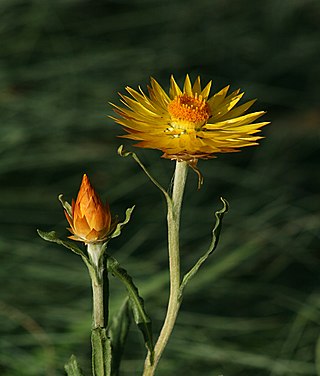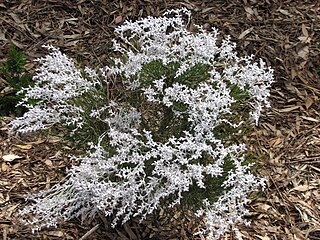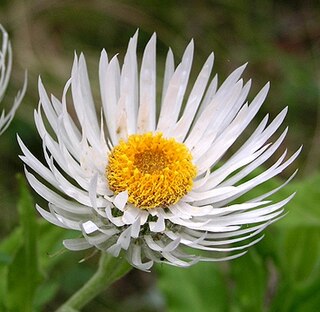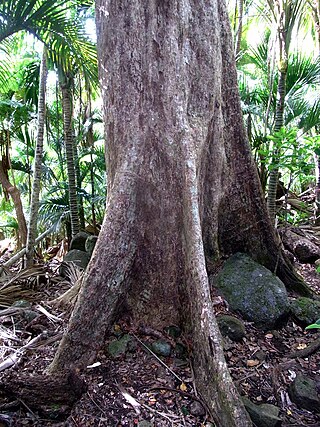
Xerochrysum bracteatum, commonly known as the golden everlasting or strawflower, is a flowering plant in the family Asteraceae native to Australia. Described by Étienne Pierre Ventenat in 1803, it was known as Helichrysum bracteatum for many years before being transferred to a new genus Xerochrysum in 1990. It is an annual up to 1 m (3.3 ft) tall with green or grey leafy foliage. Golden yellow or white flower heads are produced from spring to autumn; their distinctive feature is the papery bracts that resemble petals. The species is widespread, growing in a variety of habitats across the country, from rainforest margins to deserts and subalpine areas. The golden everlasting serves as food for various larvae of lepidopterans, and adult butterflies, hoverflies, native bees, small beetles, and grasshoppers visit the flower heads.

Xerochrysum is a genus of flowering plants native to Australia. It was defined by Russian botanist Nikolai Tzvelev in 1990, preceding Bracteantha which was described the following year. A 2002 molecular study of the tribe Gnaphalieae has indicated the genus is probably polyphyletic, with X. bracteatum and X. viscosum quite removed from each other.

Banksia nobilis, commonly known as the golden dryandra, great dryandra or kerosene bush, is a shrub of the family Proteaceae which is endemic to Western Australia. It occurs on lateritic rises from Eneabba to Katanning in the state's Southwest Botanic Province. With large pinnatifid leaves with triangular lobes, and a golden or reddish pink inflorescence, it is a popular garden plant. It was known as Dryandra nobilis until 2007, when all Dryandra species were transferred to Banksia by Austin Mast and Kevin Thiele. There are two subspecies, B. nobilis subsp. nobilis and B. nobilis subsp. fragrans.

Banksia proteoides, commonly known as king dryandra, is a shrub endemic to Western Australia. It was known as Dryandra proteoides until 2007, when all Dryandra species were transferred to Banksia by Austin Mast and Kevin Thiele.
Conospermum acerosum, commonly known as needle-leaved smokebush, is a shrub endemic to Western Australia
Conospermum glumaceum, commonly known as hooded smokebush, is a shrub endemic to Western Australia.

Conospermum stoechadis, commonly known as common smokebush, is a shrub endemic to Western Australia.
Conospermum stoechadis subsp. sclerophyllum is a shrub endemic to Western Australia.

Stirlingia simplex is a plant endemic to Western Australia.

Calomeria is a plant genus in the family Asteraceae.

Pseudognaphalium luteoalbum, synonyms including Helichrysum luteoalbum, is a species of flowering plant in the family Asteraceae. In the United Kingdom, it is known as the Jersey cudweed.

Adenanthos barbiger, the hairy jugflower or hairy glandflower, is a species of shrub in the family Proteaceae. It is endemic to the south-west of Western Australia. It usually grows to 1 metre high, and has bright red flowers that appear mostly between August and December. The species was first formally described in 1839 by English botanist John Lindley in A sketch of the vegetation of the Swan River colony.

Coronidium boormanii is a perennial herbaceous shrub in the family Asteraceae found in Australia. Previously known as Helichrysum boormanii, it was given its new name in 2008.
Xerochrysum papillosum is a herbaceous shrub in the family Asteraceae, native to southern Victoria and Tasmania. It was known variously as Xeranthemum papillosum, Helichrysum papillosum, and Bracteantha papillosa before gaining its current name in 2001.

Coronidium scorpioides, commonly known as the button everlasting, is a perennial herbaceous shrub in the family Asteraceae found in Australia. Previously known as Helichrysum scorpioides, it was placed in the newly described genus Coronidium in 2008.

Syzygium fullagarii, commonly known as the scalybark, is a relatively large tree in the family Myrtaceae. It is found only on Lord Howe Island. It grows to 20 metres tall, up to an altitude of 400 metres above sea level in sheltered areas, often in rainforest. The bark is reddish brown, usually flaking to the touch. The base of the tree is often heavily buttressed. Known for many years as Cleistocalyx fullagarii, however, in recent times it has been placed in the large genus Syzygium.

Ozothamnus cuneifolius, commonly known as wedge-leaf everlasting or wedge everlasting, is a shrub in the family Asteraceae. It is native to forests of the south-east of New South Wales and Gippsland in Victoria in Australia.

Ozothamnus rogersianus, commonly known as Nunniong everlasting, is a shrub in the family Asteraceae. It is endemic to Victoria, Australia.

Dipodium pictum, commonly known as brittle climbing-orchid or climbing hyacinth-orchid, is an orchid species that is native to Malesia and the Cape York Peninsula in Australia.

Thelymitra antennifera, commonly called the rabbit-eared sun orchid, lemon-scented sun orchid or vanilla orchid is a species of orchid which is native to Western Australia, South Australia and Victoria and northern parts of Tasmania.
















